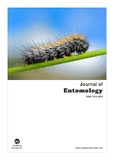| dc.contributor.author | Kega, VM | |
| dc.contributor.author | Nderitu, JH | |
| dc.contributor.author | Kasina, M | |
| dc.contributor.author | Olubayo, F | |
| dc.date.accessioned | 2015-09-30T07:16:55Z | |
| dc.date.available | 2015-09-30T07:16:55Z | |
| dc.date.issued | 2015 | |
| dc.identifier.citation | "V.M. Kega, J.H. Nderitu, M. Kasina and F. Olubayo Influence of Cropping and Irrigation Systems on Population Fluctuation of the African White Rice Stem Borer (Maliarpha separatella Rag) and Damage on Rice. J. Entomol., 12 (2): PP. 95-102 | en_US |
| dc.identifier.uri | http://scialert.net/qredirect.php?doi=je.2015.95.102&linkid=pdf | |
| dc.identifier.uri | http://hdl.handle.net/11295/91612 | |
| dc.description.abstract | Information on the population fluctuatio
n of African white rice stem borer (
Maliarpha
separatella
Ragonot), which is a major rice pest in Kenya, is not known. Availability of such
information can assist in the development of an
integrated management strategy for the pest.
Therefore, a study was conducted at Mwea irrigati
on scheme in Central Kenya, to investigate the
influence of irrigation water provision and cropping systems on population of
M. separatella.
Farmer fields in different parts of the scheme we
re sampled every fortnight. The farms represented
three irrigation water provision schedules an
d three cropping systems regimes. The irrigation
water provision schedules were, Syst
em of Rice Intensification (SRI
), flood irrigated (conventional
method) and sporadic irrigation. The cropping
systems were main season crop (conventional
method), double crop and ratoon. Water provisio
n schedules were treated as main plots, while
cropping systems were the sub plots. Results showed that the highest percentage of white
heads (13.66) occurred in areas, where rice wa
s double-cropped and where, there was sporadic
water provision (9.70). There were no significant
differences in the number of white heads
(empty panicles) between the on-season (6.37) an
d ratoon (4.25) cropping system. There were also
no differences between flood (4.42) and System for
rice intensification (5.48) methods of irrigation.
This study demonstrates that irrigation
methods and cropping systems greatly influence
fluctuation of
M. separatella
infestation and suggests that in
case of double cropping it will be
necessary to control the stem bore
r and efforts should be made to
ensure that farmers synchronize
planting dates | en_US |
| dc.language.iso | en | en_US |
| dc.publisher | University of Nairobi | en_US |
| dc.subject | Rice, cultural practices, African white rice stem borer, population | en_US |
| dc.title | Influence of Cropping and Irrigation Systems on Population Fluctuation of the African White Rice Stem Borer (Maliarpha separatella Rag) and Damage on Rice. Journal of Entomology, 2015 | en_US |
| dc.type | Article | en_US |
| dc.type.material | en_US | en_US |

